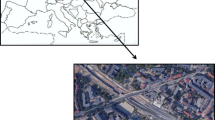Abstract
This study evaluates the airborne microflora in research laboratories of the University of Chieti (Italy). A quali-quantitative evaluation of the index microbial air contamination was performed using the settle plate method. The microbial air contamination was evaluated during 6 months in three university buildings (A, B, and C). Nutrient agar plates were exposed, monthly, for 1 h at the morning and the afternoon to evaluate the colony forming units per plate per hour. Together with the quantitative analysis, the most frequent bacterial and fungal colonies isolated were also characterized. Moreover, in each sampling, the number of the occupants in each room was recorded to evaluate a possible relationship with the microbial pollution. The microbial concentration was always within the limit values defined for these environments. Buildings A and C displayed a seasonal fluctuation of airborne microflora with the increase in microbial concentration in the warmer season (April to June) in respect to the colder period (October to December). The most common microorganisms detected in the indoor air of the examined buildings were Gram-positive bacteria, belonged to the genera Staphylococcus, Bacillus, and Actinomyces. Data presented here underline the useful monitoring of the research university laboratories also emphasizing the effectiveness of the settle plate method.
Similar content being viewed by others
References
ACGIH (American Conference of Governmental Industrial Hygienists) (1999). In J. Macher (Ed.), Bioaerosols assessment and control (pp. 322). Cincinnati, Ohio: American Conference of Governmental Industrial Hygienists.
Anzidei, P., Frusteri, L., Giovinazzo, R., Guerrera, E., Sarto, D., Todaro, N., et al. (2005). Il monitoraggio microbiologico negli ambienti di lavoro-campionamento e analisi, INAIL. Consulenza Tecnica Accertamento Rischi e Prevenzione. Canadian Medical Association Journal, 179, 147–152.
Bakke, J. V., Norbäck, D., Wieslander, G., Hollund, B. E., Florvaag, E., Haugen, E. N., et al. (2008). Symptoms, complaints, ocular and nasal physiological signs in university staff in relation to indoor environment—temperature and gender interactions. Indoor Air, 18, 131–143.
Burge, P. S. (2004). Sick building syndrome. Occupational and Environmental Medicine, 61, 185–190.
Cellini, L., Di Campli, E., Di Candia, M., & Chiavaroli, G. (2001). Quantitative monitoring in a dental office. Public Health, 115, 301–305.
Dales, R., Liu, L., Wheeler, A. J., & Gilbert, N. L. (2008). Quality of indoor residential air and health Canadian Medical Association Journal, 179 147–152.
Douwes, J., Thorne, P., Pearce, N., & Heederik, D. (2003). Bioaerosol health effects and exposure assessment: Progress and prospects. Annals of Occupational Hygiene, 47, 187–200.
Ellis, D. H. (1994). Clinical mycology—The human opprtunistic mycoses. Australia: Gillingham Printers.
Górny, R. L. (2004). Filamentous microorganisms and their fragments in indoor air-a review. Annals of Agricultural and Environmental Medicine, 11, 185–197.
Hyvärinen, A., Vahteristo, M., Melkin, T., Jantunen, M., Nevalainen, A., & Moschandreas, D. (2001). Temporal and spatial variation of fungal concentrations in indoor air. Aerosol Science and Technology, 35, 688–695.
Jaakkola, J. J., & Miettinen, P. (1995). Ventilation rate in office buildings and sick building syndrome. Occupational and Environmental Medicine, 52, 709–714.
Katušin-Ražem, B., Mihaljević, B., & Razem, D. (2003). Microbial decontamination of cosmetic row materials and personal care products by irradiation. Radiation Physics and Chemistry, 66, 309–316.
Obbard, J. P., & Fang, L. S. (2003). Airborne concentrations of bacteria in a hospital environment in Singapore. Water, Air, & Soil Pollution, 144, 333–341.
Oliver, J. D. (2005). The viable but nonculturable state in bacteria. Journal of Microbiology, 43, 93–100.
Pasquarella, C., Pitzurra, O., & Savino, A. (2000). The index of microbial air contamination. The Journal of Hospital Infection, 46, 241–256.
Pasquarella, C., Sansebastiano, G. E., Ferretti, S., Saccani, E., Fanti, M., Moscato, U., et al. (2007). A mobile laminar air flow unit to reduce bacterial contamination at surgical area in a conventionally ventilated operating theatre. The Journal of Hospital Infection, 66, 313–319.
Pastuszka, J. S., Kyaw Tha Paw, U., Lis, D. O., Wlazlo, A., & Ulfig, K. (2000). Bacterial and fungal aerosol in indoor environment in Upper Silesia, Poland. Atmospheric Environment, 34, 3833–3842.
Qudiesat, K., Abu-Elteen, K., Elkarmi, A., Hamad, M., & Abussaud, M. (2009). Assessment of airborne pathogens in healthcare settings. African Journal of Microbiology Research, 3, 66–76.
Sobotová, L., Nosková, T., Voleková, J., & Ághová, L. (2003). Understanding the role of hospitals and their environment in practical training. Management of Environmental Quality: An International Journal, 14, 344–352.
Tsai, F. C., & Macher, J. M. (2005). Concentrations of airborne culturable bacteria in 100 large US office buildings from the BASE study. Indoor Air, 15, 71–81.
Venkateswaran, K., Hattori, N., La Duc, M. T., & Kern, R. (2003). ATP as a biomarker of viable microorganisms in clean-room facilities. Journal of Microbiological Methods, 52, 367–377.
Wan-Kuen, J., & Young-Jun, S. (2005). Indoor and outdoor bio-aerosol levels at recreation facilities, elementary schools and homes. Chemosphere, 61, 1570–1579.
Wu, P. C., Li, Y. Y., Chiang, C. M., Huang, C. Y., Lee, C. C., Li, F. C., et al. (2005). Changing microbial concentrations are associated with ventilation performance in Taiwan’s air conditioned office buildings. Indoor Air, 15, 19–26.
Author information
Authors and Affiliations
Corresponding author
Rights and permissions
About this article
Cite this article
Di Giulio, M., Grande, R., Di Campli, E. et al. Indoor air quality in university environments. Environ Monit Assess 170, 509–517 (2010). https://doi.org/10.1007/s10661-009-1252-7
Received:
Accepted:
Published:
Issue Date:
DOI: https://doi.org/10.1007/s10661-009-1252-7




